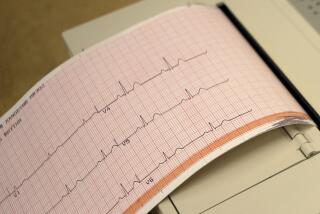UCI Researchers, Firm Join in Alzheimer’s Fight : Medicine: A San Diego company will support studies aimed at developing a clinical test for the disease.
- Share via
IRVINE — The University of California regents and two UC Irvine researchers said Monday that they have signed a licensing agreement with a San Diego company for research technologies that could lead to a diagnostic test for Alzheimer’s disease.
Although 4 million Americans are believed to suffer from Alzheimer’s, and 100,000 die of the disease each year, there is no sure method for diagnosing the progressive, degenerative brain disease.
Doctors use a combination of brain scans and psychological evaluations to reach a preliminary diagnosis of Alzheimer’s, but the diagnosis can only be confirmed by an autopsy.
The UCI researchers hope to develop a clinical test for the disease by measuring the levels of a protein fragment they believe is found in lower-than-normal levels in the cerebral spinal fluid of Alzheimer’s patients, said William T. Comer, president and chief executive of the San Diego-based Salk Institute Biotechnology/Industrial Associates Inc. (SIBIA), which has purchased rights to the technology.
If the scientific approach proves correct, the UCI technology could also have potential applications in developing drugs to treat Alzheimer’s disease, though it would probably be a decade before such a drug would reach the market, Comer said.
Under the licensing deal announced Monday, SIBIA will provide a $2.8-million, seven-year grant to support research at the UCI laboratory headed by Dennis Cunningham, chairman of the Department of Molecular Genetics. Cunningham has been collaborating with scientists William Van Nostrand, who will continue his research at UCI, and Steven L. Wagner, who formerly worked in the Cunningham lab but has since joined SIBIA.
Other financial details were not disclosed. However, as part of the agreement, the university will own about 1.5% of SIBIA stock, and SIBIA will reimburse the university system for the costs of applying for three patents based on the scientists’ work, Comer said. The patents, which will be held by the regents, are still pending, he said.
SIBIA will have the exclusive worldwide rights to commercialize the three patents and the associated technology, Comer said.
About a dozen other research groups and private companies are also trying to develop a diagnostic test for Alzheimer’s. One of SIBIA’s competitors, Athena Neurosciences Inc. of South San Francisco, has been collaborating for three years with Eli Lilly & Co. to develop treatments for the disease, and in July signed an agreement with Hybritech Inc. of San Diego to develop a diagnostic test, said Athena Executive Vice President Paulette Setler.
Many pharmaceutical companies also are attempting to develop drugs to treat Alzheimer’s, though none have been approved by the Food and Drug Administration. In July, the FDA decided to allow wider distribution of the drug Tacrine, or THA, manufactured by Warner-Lambert Co., while the drug is being studied, though the FDA said the drug’s clinical effectiveness remains unproven.
However, a number of research groups claim to be close to identifying the precise cause of Alzheimer’s.
The most prominent sign of the disease is the deposits of protein plaques in the parts of the brain that control memory and learning. The plaques, composed mainly of beta-amyloid, can sometimes be detected in CAT or other brain scans but can be clearly seen in an autopsy.
Researchers suspect that Alzheimer’s may be caused when a protein called amyloid precursor protein, or APP, is broken down by brain cells in an abnormal way that leaves part of the substance inside the cell membrane, where it accumulates and causes plaque, Comer said.
The plaque then chokes the brain’s neurons, which die, leading to memory loss, disorientation, deterioration of bodily function and eventually death, Comer said.
However, because the protein fragment, called Protease Nexin II (PN-II), is left behind in the cell membrane, it is not excreted normally. The UCI group has identified a monoclonal antibody that detects the presence of PN-II in cerebral spinal fluid, Comer said.
In preliminary testing of 75 patients, most from the UCI Alzheimer’s center, those believed to have Alzheimer’s had significantly lower levels of PN-II than either normal patients or people suffering from dementias caused by strokes or other problems, Comer said.
SIBIA is now conducting larger-scale testing, and hopes to learn, among other things, how early the PN-II test can detect the disease, Comer said. If the approach proves correct and all goes smoothly, he said, the company would hope to have a commercial diagnostic test for Alzheimer’s in about two years.
Eventually, by identifying specific enzymes that inhibit beta-amyloid deposits, SIBIA hopes to produce a drug that would halt the progression of the disease, Comer said.
Meanwhile, the ability to accurately diagnose Alzheimer’s through a biochemical test would be a major help in developing drugs to treat the disease, Cunningham said.
“In order to determine the efficacy of a potential therapeutic agent, you need to have a criteria by which to judge the severity of the disease, how it’s progressing, and whether there would hopefully be some regression of the disease with a successful (drug),” he said.
Founded in 1981, SIBIA is a privately held company whose major shareholders are the Salk Institute, the La Jolla medical research center; Phillips Petroleum Co. and Skandigen AB of Sweden. It is also working on diagnostic tests and treatments for Parkinson’s disease, epilepsy and stroke, but has yet to commercialize a product, Comer said.






